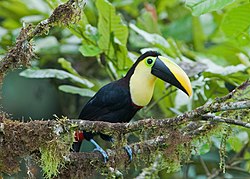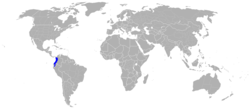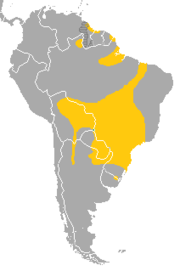Evolution
Phylogenetics
The phylogenetic relationships among toucans have been the subject of ongoing debate and research; in the past, the eight toucan species were classified into different subfamilies based on their bill size and shape. However, recent molecular studies have suggested that toucans are more closely related to aracaris and toucanets than previously thought. Several species have also been removed from the Ramphastos genus: Green aracari, Ivory-billed aracari, Black-necked aracari, Collared aracari, Saffron toucanet.
One such study published in the journal Molecular Phylogenetics and Evolution in 2015, [15] used molecular data to investigate the phylogenetic relationships among toucans. The researchers sequenced several nuclear and mitochondrial genes from 40 toucan species, representing all recognized subgenera within the genus Ramphastos. The study found that toucans could be divided into six distinct clades, each with different bill morphologies and geographic distributions. The study also suggested that the toucan genus had diversified during the Pliocene epoch, around 5 million years ago, with the rapid diversification of several lineages during the Pleistocene epoch, around 1 million years ago.
The Ramphastos genus is divided into two groups which differ in the shape of their bills and their vocalization patterns. These two groups are known colloquially as the “croakers'' and the “yelpers”. The “croakers'' contain the following: R. brevis, R. dicolorus, R. sulfuratus, R. toco, and R. vitellinus. The “yelper” group contains: R. ambiguous and R. tucanus. Of these, R. brevis and R. dicolorus are polytypic.
History
The evolutionary history of toucans can be traced back to the Eocene period, around 50 million years ago, the first toucan-like bird,may have appeared in Europe. The modern toucan species, however, originated in South America during the Miocene period, around 23 million years ago.
Transposable Elements
Transposable elements are a major source of genetic diversity and can contribute to the evolution of new genes and regulatory elements. Transposable elements have been found in the genomes of all organisms studied so far, including the Ramphastos genus.
One study published in the journal Genome Biology in 2018, [16] used a combination of genomic and phylogenetic analyses to investigate the role of transposable elements in the evolution of toucans. The researchers sequenced the genome of the green-billed toucan (Ramphastos dicolorus) and compared it to the genomes of other bird species. They found that transposable elements were abundant in the toucan genome, making up approximately 19% of the genome.
The researchers also identified several families of transposable elements that were specific to toucans, indicating that these elements had played a role in the evolution of the toucan genome. In particular, the researchers identified a family of elements called CR1, which had undergone a burst of activity in the toucan genome. This burst of activity was associated with the expansion and diversification of several gene families that are involved in sensory perception and immune response.
The study also found that transposable elements had contributed to the evolution of the toucan bill, which is one of the most distinctive features of toucans. The researchers identified several genes involved in the development of the bill that had been influenced by these elements. In particular, they found that they had inserted into regulatory regions of the genes, altering their expression patterns and contributing to the development of the large and colorful bill.
This page is based on this
Wikipedia article Text is available under the
CC BY-SA 4.0 license; additional terms may apply.
Images, videos and audio are available under their respective licenses.




























